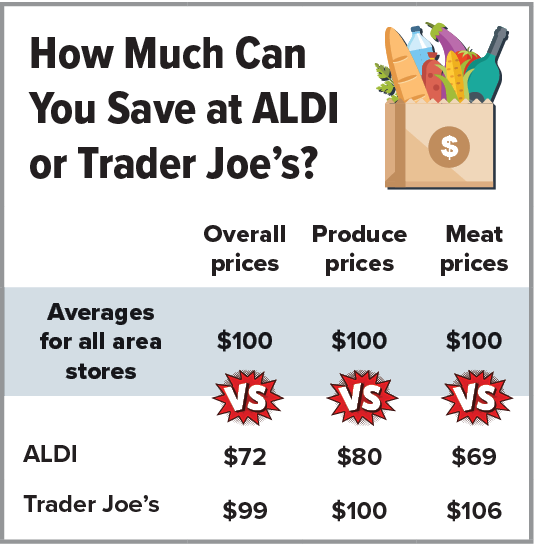How do Trader Joe’s and ALDI’s Prices Compare?
Last updated November 2025
German-based discounter ALDI, ubiquitous in most of western Europe, continue to expand its U.S. footprint. ALDI focuses on low costs, and our survey of prices at area grocery stores found ALDI quite inexpensive: For our shopping list, ALDI’s prices were 28 percent lower than the all-store average; its per-unit prices were as low as BJ’s and Costco.
These savings are partly explained by ALDI’s smaller-format stores, which have much lower overhead costs than conventional supermarkets.
ALDI also benefits from different expectations. Shoppers at Market Basket, Stop & Shop, Walmart, etc., expect to always find their favorite brands on the shelves. Like Trader Joe’s, ALDI carries mostly its own brands, not national-brand products. ALDI does offer some national brands, but overall, selection is limited. In other words, you’ll find some of the most popular brands (Coke, Heinz ketchup, Hellmann’s mayo, etc.) at ALDI, but probably only in one size.
Instead, ALDI’s shoppers trade that quirkiness for comparable very-low-priced products.
Although its prices were higher than ALDI, Trader Joe’s still offered savings compared to most traditional supermarket chains. And it continues to earn highly favorable ratings from its customers overall.
We used a modified survey when collecting prices for ALDI and Trader Joe’s and comparing them with conventional supermarkets. Because our market basket of 150 items largely consists of national-brand products, and because these three companies offer mainly their own brands, we couldn’t compare their prices using our standard price survey. Instead, we developed a special survey that included the same fresh produce, meats, and dairy items as in our standard survey, but for conventional grocery stores we substituted their cheapest available comparable store brands. (When comparing prices, we used per-unit pricing—for example, price per ounce.)



